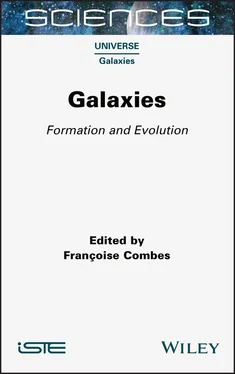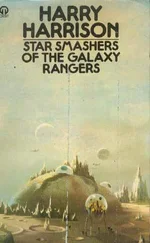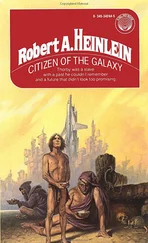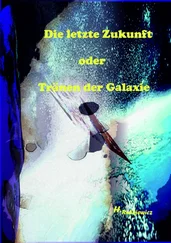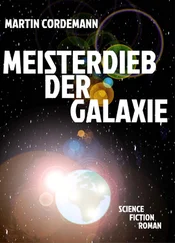
Figure 1.4. A cross-section through the CVRHS system of families and varieties including the de Vaucouleurs (1963) underline notation. The central “cell” is meant to extend the concept of galactic varieties to outer and nuclear features, as well as additional inner features such as lenses
de Vaucouleurs (1963) also introduced the underline notation for stages, as in SA(s)ab, which means “closer to Sb than to Sa”. Although this notation can be applied directly as for families and inner varieties, it has appeared mainly in classifications based on averages of multiphase (or repeat) efforts designed to check for consistency (e.g. Buta et al . 2015). This usage of underlines for stages, families and varieties considerably increases the number of “cells” in the CVRHS as compared to the VRHS, and one may well question whether some of these cells might not have any entrants. Buta (2019) showed that for the EFIGI sample, the cells of the CVRHS system are roughly evenly occupied among late S0s and early-type spirals, but not among later-type spirals. This means the classification volume lacks the symmetry depicted in Figure 1.3.
In the following sections, the different types of galaxies are described in more detail.
For more than two decades, elliptical galaxies were the subject of the most intense extragalactic research, spawning many meetings and research papers that underscored how deceptive the simple appearance of these galaxies is. When studied in detail both photometrically and spectroscopically, it becomes clear that the history of ellipticals is likely very complex. The main issues examined in detail are as follows: isophote shapes and orientations; characteristics of luminosity profiles; the presence of dust, rings, and peculiar structures; how low-luminosity ellipticals connect to high luminosity ellipticals; and the characteristic scaling relations between measured quantities such as physical size, surface brightness and central velocity dispersion.
The VRHS system as depicted in Figure 1.3interprets E galaxies in terms of two stages: E and E +. A normal elliptical (E) shows a smooth decline in brightness as a function of galactocentric distance, with no inflections or other apparent structure. Type E +galaxies are considered as “late” ellipticals showing some traces of structure. The structure can be in the form of a subtle lens, a feature that when more apparent is seen to have a shallow brightness gradient interior to a sharp edge (Sandage 1961; Kormendy 1979). In the Third Reference Catalogue of Bright Galaxies (RC3; de Vaucouleurs et al . 1991), the E +classification was also applied to brightest cluster members having a shallow brightness gradient (or an apparent extended envelope) in the outer regions. In the Morgan (1958) classification system, such objects are classified as type cD. Examples of E and E +galaxies are shown in Figures 1.5and 1.6. Other aspects of E galaxy morphology include the following:
Disky versus boxy isophotes : The shapes of E galaxy isophotes carry important clues to their history. Kormendy and Bender (1996) noted how Hubble’s main E galaxy classification criterion, the apparent flattening (as in, e.g. E3), had little physical significance, being determined mainly by how a galaxy is viewed. Very few ellipticals are recognized as being more flattened than E4. NGC 4623 in Figure 1.5is as close as any real galaxy comes to being a genuine E7. Nevertheless, it shows a faint trace of a thin disk ( section 1.5).

Figure 1.5. Examples of elliptical galaxies ranging from round in apparent shape (E0) to fairly elongated (E6). Sandage and Bedke (1994) considered NGC 4623 (lower right frame) to be a possible example of a genuine E7 galaxy. Very few ellipticals are more flattened than E4
Capaccioli (1987) noted two families of elliptical galaxies at a time when any trace of a disk component in a galaxy classified as type E was taken to mean that the galaxy was a misclassified S0 galaxy. Kormendy and Bender (1996) proposed a reclassification of ellipticals into disky and boxy categories based on the sign of the cos 4 θ relative Fourier deviation from perfectly elliptical isophotes. If the relative amplitude of this term is positive, the isophotes are said to be cuspy (or “disky”), but if negative, the isophotes are boxy. Cuspy isophotes are interpreted as indicating the presence of a subtle disk component, likely to be made of accreted material. Boxy isophotes are also thought to be indicative of interactive history. If an E galaxy is disky, it is classified as type E(d), while if an E galaxy is boxy, the type is E(b). The distinction of these subcategories can depend on how we are viewing the structures. For example, if the subtle disk in an E galaxy is oriented more nearly face-on rather than edge-on, then the isophotes will not necessarily show a cuspy shape. Both boxiness and diskiness are favored to be seen in the edge-on view. Several examples are shown in Figure 1.7. The CVRHS adopts the E(b) and E(d) terminology of Kormendy and Bender (1996) when these distinctions are obvious in a visual inspection of images.

Figure 1.6. E + galaxies are generally elliptical galaxies with very subtle traces of structure, usually in the form of a lens, a feature with a shallow brightness gradient interior to a sharp edge. Lenses are more prominent in S0 galaxies. The bottom row shows three brightest cluster members that are best interpreted as Morgan cD (supergiant) galaxies but which have also been considered E + galaxies by de Vaucouleurs
Isophote twisting : Isophote twisting, where the ellipticity and position angle of the major axis of the isophotes of an E galaxy change systematically with increasing radius, is thought to be the principal evidence favoring triaxial intrinsic shapes (e.g. Fasano and Bonoli 1989). In a triaxial galaxy, there are three principal axes, each having a different radial scale-length. This highlights how the observed ellipticity of an E galaxy cannot be interpreted as easily as that of a disk-shaped galaxy. There is also the possibility, as noted by Nieto (1988), that some isophote twisting in E galaxies is due to an incipient bar structure in a very “early” SB0 galaxy. Tsatsi et al . (2017) detected evidence of prolate rotation in eight early-type galaxies, again supporting the idea of triaxial shapes.

Figure 1.7. Examples of disky and boxy elliptical galaxies. Generally, the disky/boxy nature of E galaxy isophotes can only be determined with detailed isophotal ellipse fits. The examples illustrated here are more obvious cases that can be distinguished in color displays of the images
Dust and gas : The presence of interstellar dust and gas in E galaxies is a likely indicator of interaction/merger history (Schweizer 1987). The orientations of planar dust lanes may be tied to the likely triaxial structure of ellipticals. This follows from the presence of minor axis dust lanes, where the dust appears along the short apparent axis of the isophotes (Bertola and Galletta 1978). In disk-shaped galaxies, the planar dust lane always appears parallel to the apparent major axis. In general, minor, major and intermediate axis dust lanes are found in E and S0 galaxies. Examples are shown in Figure 1.8. In the CVRHS system, dust-lane Es are specified as E (dust-lane).
Читать дальше
